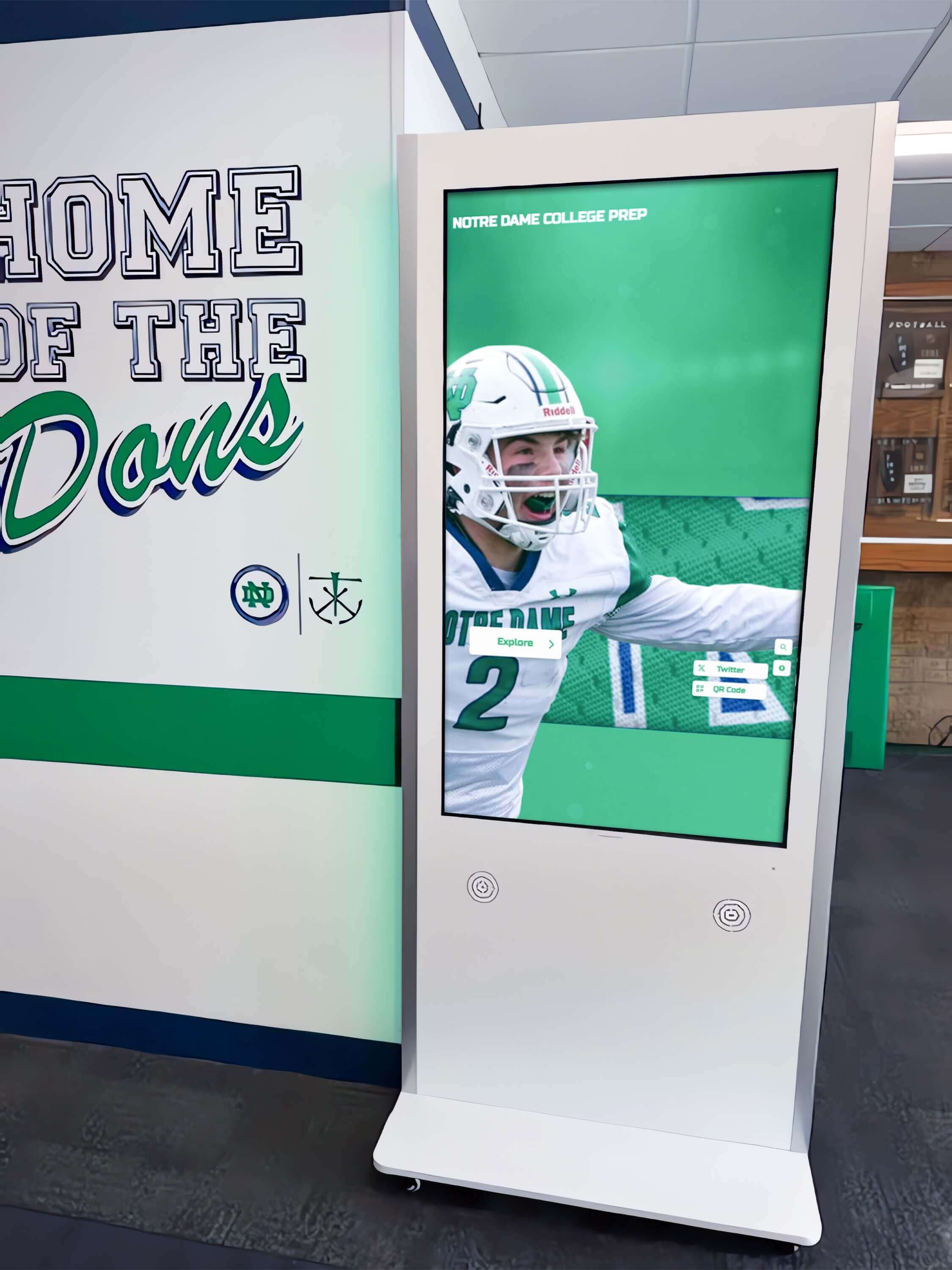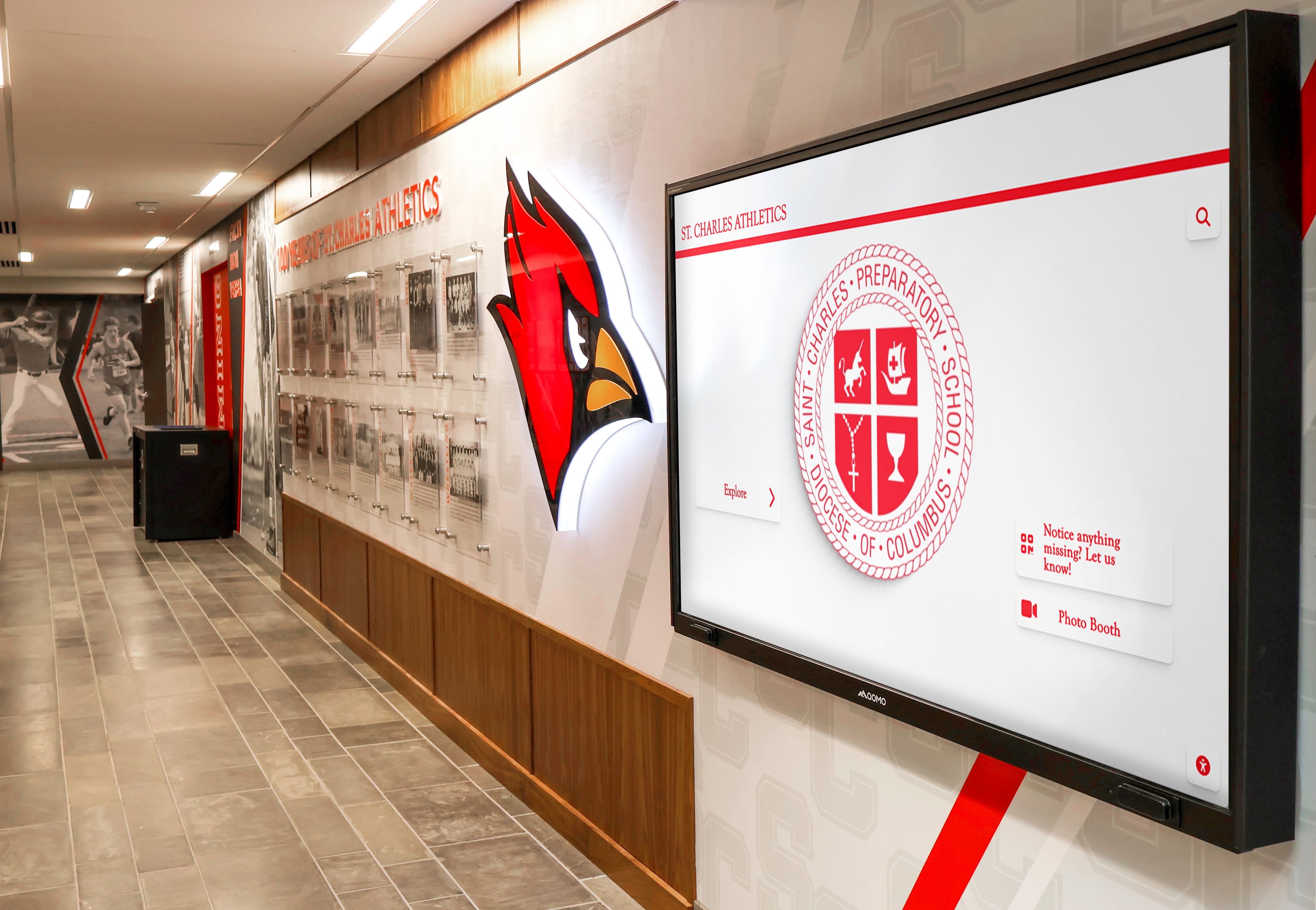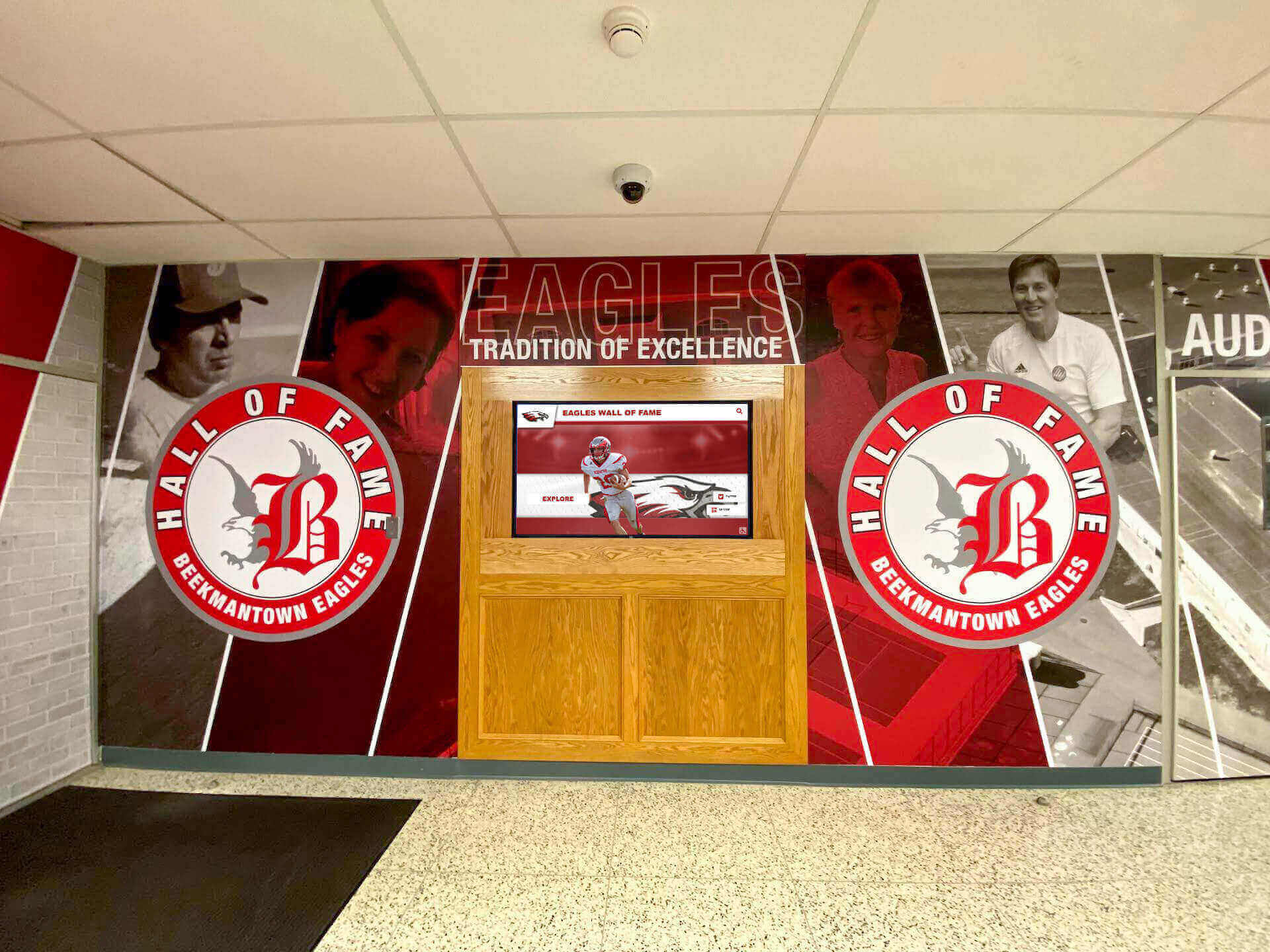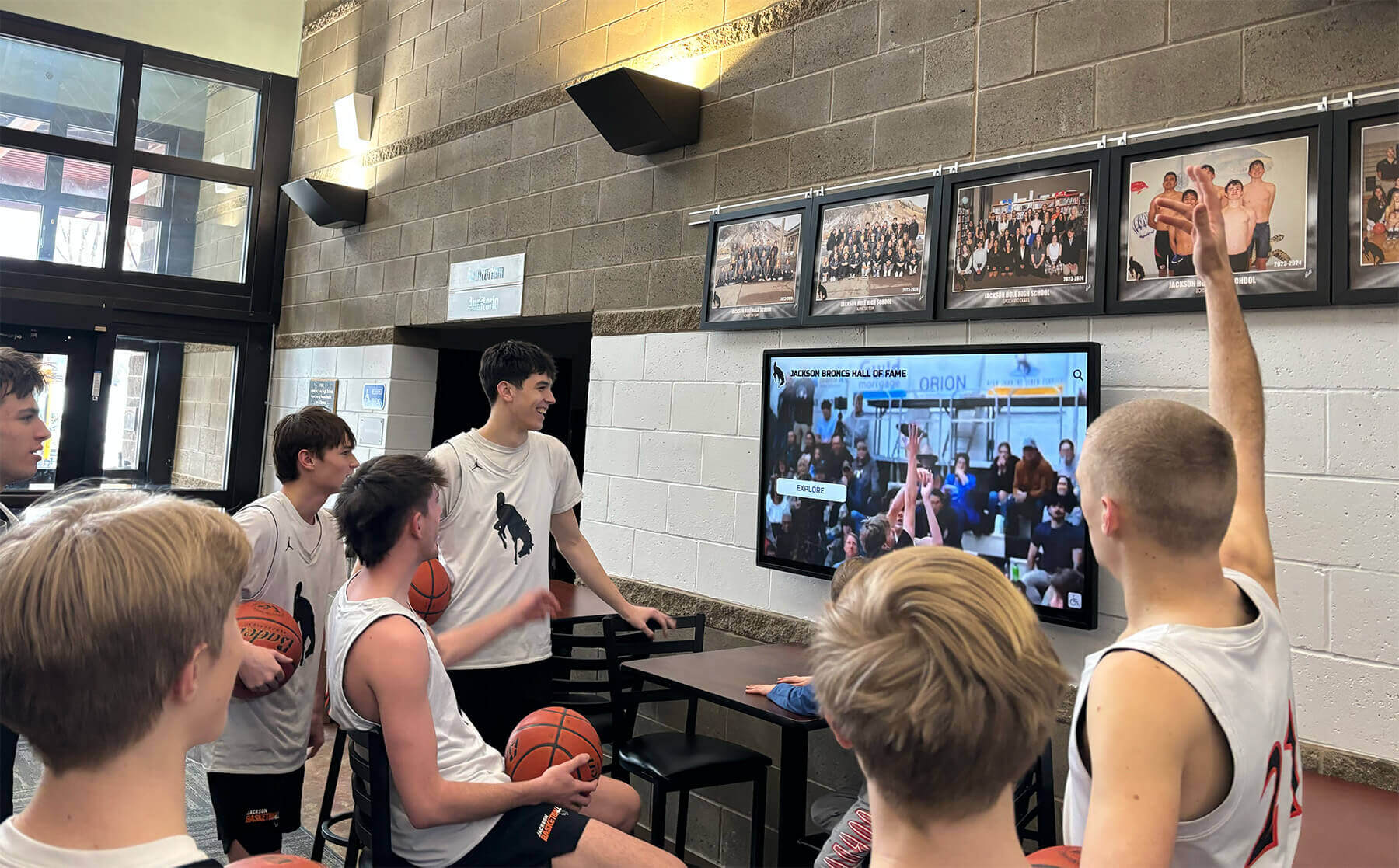Teachers face increasing demands, budget constraints, and complex challenges while remaining deeply committed to student success. In this environment, meaningful appreciation becomes more than a nice gesture—it’s essential for retention, morale, and creating positive school cultures where educators feel valued and supported.
Digital touchscreen displays designed for teacher recognition provide schools with dynamic, engaging platforms that celebrate educators year-round, not just during Teacher Appreciation Week. These interactive systems enable rich multimedia storytelling, allow ongoing content updates, and create public-facing tributes that honor teaching excellence while inspiring students and connecting with families.
This comprehensive guide explores how schools can implement touchscreen displays for teacher appreciation, examining content strategies, implementation approaches, budget considerations, and real-world applications that transform how educational communities recognize and celebrate their most valuable resource: exceptional educators.
Why Teacher Appreciation Matters More Than Ever
The teaching profession faces unprecedented challenges affecting recruitment, retention, and educator wellbeing across districts nationwide.
The Teacher Retention Crisis
According to the National Center for Education Statistics, teacher turnover rates have reached concerning levels, with approximately 8% of teachers leaving the profession annually and another 8% moving to different schools. High turnover disrupts student learning, strains remaining staff, and costs districts significant resources in recruitment and training.
Exit interviews consistently reveal that teachers leaving the profession cite lack of administrative support, insufficient recognition, and feeling undervalued as primary factors. While salary concerns exist, research demonstrates that workplace culture, appreciation, and feeling respected significantly influence retention decisions.
Recognition’s Impact on Teacher Morale
Multiple studies document strong correlations between teacher recognition and job satisfaction, engagement, and retention. Teachers who feel appreciated by administrators, colleagues, students, and families demonstrate higher morale, greater resilience during challenges, and stronger commitment to their schools.
Recognition validates the often-invisible work teachers perform: the extra hours preparing lessons, the emotional support provided to struggling students, the personal funds spent on classroom supplies, and the genuine care invested in young people’s development. Public acknowledgment through prominent, professional recognition systems demonstrates institutional commitment to educators’ value.
Creating Positive School Culture
School culture directly influences student outcomes, teacher effectiveness, and family engagement. Schools with strong appreciation cultures—where excellence is celebrated, contributions are acknowledged, and individuals feel valued—consistently outperform comparable schools lacking these cultural elements.

Digital recognition displays create visible, tangible manifestations of appreciation culture. When students, parents, and visitors see teachers honored prominently, it reinforces education’s importance and elevates teaching to its rightful position as respected, valued work deserving celebration.
Understanding Touchscreen Displays for Teacher Recognition
Interactive touchscreen displays offer unique capabilities specifically valuable for honoring educators in school environments.
What Are Touchscreen Recognition Displays?
Touchscreen recognition displays combine large-format digital screens (typically 43-75 inches) with touch-sensitive interfaces, mounting systems, and specialized software designed for showcasing recognition content. Unlike static bulletin boards or digital slideshow displays, these interactive systems allow users to explore content actively—browsing teacher profiles, watching video tributes, reading student testimonials, and discovering educator achievements.
Modern touchscreen technology provides intuitive interaction requiring no technical knowledge. Students, parents, and visitors simply touch the screen to navigate, similar to smartphones or tablets but with much larger displays optimized for public spaces.
Key Features for Teacher Appreciation
Rich Multimedia Content: Touchscreen displays support diverse content types that bring teacher recognition to life:
- Professional photographs highlighting educators in action
- Video tributes featuring students, colleagues, and families
- Written biographies detailing career achievements and contributions
- Student testimonials and appreciation messages
- Award acknowledgments and certifications
- Teaching philosophy statements in educators’ own words
Interactive Exploration: Unlike static displays showing limited information, interactive systems allow users to discover extensive content about each teacher:
- Detailed career histories and educational backgrounds
- Subject expertise and teaching specializations
- Years of service and career milestones
- Professional development and continuing education
- Community involvement and volunteer work
- Personal interests and hobbies humanizing educators
Ongoing Updates and Additions: Digital platforms enable continuous recognition, not just annual events:
- Welcome new teachers with immediate profile additions
- Celebrate milestones like teaching anniversaries and retirements
- Acknowledge awards, certifications, and professional achievements
- Feature rotating “Teacher Spotlight” content throughout the year
- Update photos and information as careers progress
- Add student and family testimonials continuously
Advantages Over Traditional Recognition Methods
Traditional Bulletin Boards:
- Limited space constraining content
- Static photos and text
- Difficult and time-consuming to update
- Easily overlooked in hallways
- Subject to fading, damage, and wear
- Capacity limits on teachers featured
Interactive Touchscreen Displays:
- Virtually unlimited content capacity
- Rich multimedia with photos, video, audio
- Easy digital updates in minutes
- Eye-catching and engaging for viewers
- Professional, permanent presentation
- Every teacher can be featured prominently
Traditional versus digital recognition solutions demonstrate clear advantages for interactive platforms in engaging viewers, showcasing comprehensive content, and maintaining current, professional presentation.
Content Strategies for Teacher Recognition Displays
Compelling content transforms touchscreen displays from impressive technology into meaningful recognition that genuinely honors educators.
Essential Profile Components
Comprehensive teacher profiles should include:
Professional Information:
- Full name and preferred name
- Subject areas and grade levels taught
- Years of service at current school and in education
- Educational background (degrees, institutions, certifications)
- Teaching philosophy statement
- Professional memberships and continuing education
Achievements and Recognition:
- Teaching awards and honors received
- Professional certifications and credentials
- Leadership roles (department chair, committee service, mentoring)
- Published works or curriculum development
- Professional conference presentations
- Grant awards and innovative program development
Personal Touches:
- Professional photograph in teaching environment
- Why they became a teacher
- Favorite aspects of teaching
- Memorable teaching moments or student successes
- Personal interests and hobbies
- Family information if comfortable sharing
Multimedia Elements:
- Video interviews with teachers discussing their passion for education
- Student video testimonials expressing appreciation
- Classroom action photos showing teachers engaged with students
- Photos from special events, field trips, or extracurricular activities
- Audio recordings of teaching philosophies or student messages
Student and Family Testimonials

Student voices provide the most powerful teacher recognition. Creating opportunities for students and families to contribute appreciation messages adds authentic emotional impact:
Collection Methods:
- Digital submission forms on school websites
- Video recording sessions with students during advisory periods
- Written testimonials collected during parent-teacher conferences
- Alumni contribution opportunities through reunion events or online portals
- Graduation reflections from seniors acknowledging influential teachers
- Anonymous submission options encouraging candid appreciation
Effective Testimonial Questions:
- “How did this teacher make a difference in your life?”
- “What will you remember most about this teacher?”
- “Describe a moment when this teacher helped you succeed”
- “What makes this teacher special?”
- “What would you want this teacher to know?”
Presentation Approaches:
- Text testimonials with student first names or initials
- Video testimonials (with appropriate permissions)
- Audio recordings of student voices reading their messages
- Artistic student creations (drawings, poems) honoring specific teachers
- Graduating class collective messages to beloved teachers
Celebrating Teaching Milestones and Achievements
Recognition displays should acknowledge significant career moments:
Years of Service Recognition: Celebrate milestone anniversaries (5, 10, 15, 20, 25, 30+ years) with special content updates featuring career retrospectives, historical photos, and reflections on changes witnessed across decades of teaching.
Award Acknowledgment: Highlight teachers receiving district Teacher of the Year, state certifications, National Board Certification, grants, fellowships, or other professional recognition. Include award descriptions and significance.
Retirement Tributes: Create comprehensive career retrospectives for retiring educators, featuring photos spanning their tenure, student testimonials collected throughout final years, colleague reflections, and video messages from alumni impacted across decades.
New Teacher Welcomes: Introduce new faculty members with warm welcome profiles, helping them feel immediately valued while helping students and families become acquainted with new educators.
Professional Development: Acknowledge teachers completing advanced degrees, specialized certifications, or significant professional development, demonstrating commitment to continuous improvement and mastery.
Implementation Planning and Strategy

Successful touchscreen display implementation requires thoughtful planning addressing location, hardware, content development, and ongoing management.
Selecting Optimal Locations
Location dramatically influences display visibility and engagement:
High-Traffic Locations:
- Main entrance lobbies where visitors, students, and staff pass daily
- Near main office where parents visit for check-in and conferences
- Cafeteria or common areas where students gather
- Library media centers as information hubs
- Auditorium lobbies before performances and events
Location Considerations:
- Adequate stopping space for multiple viewers to gather comfortably
- Clear sight lines from major pathways attracting attention
- Appropriate lighting avoiding glare while ensuring visibility
- Accessible mounting heights complying with ADA requirements
- Proximity to power and network infrastructure
- Physical security preventing vandalism or damage
Multi-Display Strategies: Larger schools may benefit from multiple displays in different areas:
- Elementary wing display featuring primary grade teachers
- Middle and high school department-specific displays
- Athletic and performing arts areas recognizing coaches and activity sponsors
- Administrative areas featuring support staff and paraprofessionals
Hardware Selection and Specifications
Display Size Recommendations:
- Small schools (under 300 students): 43-55 inch displays
- Medium schools (300-800 students): 55-65 inch displays
- Large schools (800+ students): 65-75 inch displays
- Multiple smaller displays often provide better coverage than single large displays
Touchscreen Technology: Commercial-grade capacitive or infrared touch technology provides responsive, reliable interaction. Infrared touch works well for larger displays (65"+) and accommodates any input method including fingers, styluses, or gloved hands.
Mounting Options:
- Wall-mounted installations for permanent, space-efficient placement
- Floor stand kiosks allowing flexible positioning and relocation
- Secure enclosures for high-traffic areas requiring vandalism protection
- Tilt-adjustable mounts accommodating optimal viewing angles
Computing and Connectivity: Displays require media players or computers running recognition software. Specifications should include:
- Sufficient processing power for responsive touch interaction
- Adequate storage for multimedia content libraries
- Reliable network connectivity (wired Ethernet preferred)
- Remote management capabilities for content updates
- Backup and recovery systems protecting content
For comprehensive guidance on hardware selection for recognition displays, evaluate factors including commercial-grade reliability, appropriate specifications for continuous operation, and total cost of ownership beyond initial purchase.
Content Development Process
Initial Content Creation:
Launching with comprehensive content requires significant upfront work but establishes the foundation for ongoing success:
Planning Phase (Week 1-2):
- Identify all teachers to feature
- Develop profile templates and content standards
- Create content collection forms and processes
- Schedule photography sessions
Data Collection (Week 3-6):
- Distribute teacher information forms
- Conduct teacher interviews for biographical content
- Schedule and complete professional photography
- Gather existing photos and documentation
- Collect initial student testimonials
Content Creation (Week 7-10):
- Write biographical content for each teacher
- Edit and process photographs
- Record and edit video content if included
- Organize testimonials and supplementary materials
- Review all content for accuracy and consistency
Review and Refinement (Week 11-12):
- Teacher review and approval of their profiles
- Administrative review ensuring policy compliance
- Final edits and corrections
- Complete content loading into software platform
- Comprehensive testing of all features and content
Realistic Timeline: Plan minimum 12-16 weeks from project initiation to public launch for thorough content development. Rushed launches with incomplete content diminish impact and require extensive post-launch remediation.
Ongoing Content Management:
Establish clear processes for maintaining current, engaging content:
- Monthly Updates: New teacher spotlights, recent achievements, seasonal themes
- Quarterly Reviews: Content accuracy verification, photo updates, adding new testimonials
- Annual Refreshes: Comprehensive content audits, new photography, major content additions
- Event-Driven Updates: Immediate recognition of awards, retirements, new hires, milestones
Budget Considerations
Cost Components:
Initial Investment:
- Display hardware: $1,200-$4,000
- Touchscreen interface: Included or $300-$800
- Media player/computer: $400-$1,200
- Mounting system: $200-$600
- Professional installation: $300-$800
- Software platform: $800-$2,500 first year
- Content development: $1,000-$5,000
- Total Initial: $4,200-$15,000
Ongoing Costs:
- Software licensing: $600-$2,000 annually
- Content management: $500-$2,000 annually
- Hardware maintenance: $200-$500 annually
- Network and power: $100-$300 annually
- Content updates: $500-$1,500 annually
- Total Annual: $1,900-$6,300
Funding Sources:
- School operating budgets or technology funds
- Parent-teacher organization (PTO/PTA) fundraising
- Education foundation grants
- Local business sponsorships
- Memorial or tribute donations honoring teachers
- Title II professional development funds (if recognition supports teacher effectiveness)
- Alumni association contributions
Cost-Benefit Considerations:
While investment appears significant, compare against ongoing costs of traditional recognition methods (printing, framing, installation) and consider intangible benefits: improved teacher retention (each retained teacher saves $10,000-$20,000 in turnover costs), enhanced recruitment attracting quality candidates, and strengthened school culture.
Solutions like Rocket Alumni Solutions provide purpose-built platforms specifically designed for educational recognition, offering content management tools, professional templates, and support services that reduce implementation complexity while controlling costs.
Best Practices for Teacher Appreciation Displays
Ensuring Inclusive Recognition
Recognizing All Educators: Comprehensive recognition should include:
- Classroom teachers across all grades and subjects
- Specialists (art, music, PE, library, counseling, special education)
- Paraprofessionals and teaching assistants
- Instructional coaches and mentors
- Support staff contributing to educational mission
- Retired teachers maintaining legacy connections
Leaving educators out—intentionally or accidentally—creates hurt and undermines the positive culture recognition programs aim to build. Budget time and resources to feature every educational professional.
Equitable Content Quality: Ensure consistent, high-quality content for all teachers, not just administrators or high-profile staff. Every educator deserves professional photography, comprehensive biographies, and meaningful recognition regardless of seniority or subject area.
Diverse Representation: Recognition content should reflect the diversity of your educational community. Highlight teachers representing different backgrounds, teaching philosophies, subjects, grade levels, and career stages, ensuring all students see themselves reflected in celebrated educators.
Maintaining Content Currency

Content Freshness: Stale content diminishes engagement. Implement processes ensuring:
- New teacher additions within first month of employment
- Prompt updates for promotions, certifications, and awards
- Current photographs refreshed every 2-3 years
- Regular testimonial additions preventing repetitive content
- Seasonal content variations maintaining visual interest
- Archived or adjusted content for departing teachers
Assigned Responsibility: Designate specific staff members responsible for content management:
- Content coordinator overseeing overall management
- Department liaisons collecting information from grade levels or subjects
- Technology staff managing technical aspects and troubleshooting
- Administrative approval process ensuring appropriateness
- Teacher volunteer committee providing content ideas and feedback
Without clear accountability, recognition displays languish with outdated content, undermining their purpose.
Protecting Privacy and Respecting Boundaries
Teacher Consent: Obtain explicit permission before featuring teachers prominently in public displays. While teachers are semi-public figures, professional ethics and respect require consent for recognition content, particularly for:
- Photographs and video content
- Personal information beyond professional credentials
- Family or personal interest information
- Student testimonials associated with specific teachers
Content Boundaries: Establish clear policies about appropriate recognition content:
- Focus on professional achievements and teaching excellence
- Avoid potentially embarrassing personal information
- Respect cultural and religious sensitivities
- Maintain professional tone avoiding overly casual content
- Protect teacher privacy regarding personal addresses, phone numbers, or other contact information
Student Privacy: When featuring student testimonials or classroom photos:
- Obtain appropriate parental permissions
- Use first names only or initials for student attributions
- Avoid identifying students with special education needs or sensitive situations
- Follow district policies on student image and information use
Integrating with School-Wide Recognition Programs
Teacher appreciation touchscreen displays work best integrated into comprehensive recognition strategies:
Complementary Recognition Methods:
- Traditional Teacher of the Year programs
- Monthly staff recognition in faculty meetings or newsletters
- Handwritten notes from administrators and colleagues
- Student-created appreciation projects during Teacher Appreciation Week
- Professional development opportunities as recognition
- Wellness initiatives supporting teacher work-life balance
Coordinated Communication: Feature recognition display content across multiple channels:
- School newsletters and websites highlighting featured teachers
- Social media posts showcasing teacher spotlight content
- Local media coverage of teaching milestones and achievements
- District communications celebrating exceptional educators
- Alumni communications connecting current and former teachers
Event Integration: Incorporate displays into school events:
- Open houses featuring teachers’ digital profiles
- Parent-teacher conferences with recognition displays nearby
- Back-to-school nights showcasing new teacher profiles
- Faculty appreciation celebrations with display presentations
- Graduation ceremonies honoring teachers who shaped senior class
Advanced Features and Enhancements
Video Testimonials and Multimedia Content

Video content creates particularly powerful emotional connections. Consider incorporating:
Teacher Interview Videos: Short 60-90 second videos featuring teachers discussing why they teach, memorable moments, or teaching philosophies provide authentic insight into educators’ passion and dedication.
Student Video Messages: Collections of brief student testimonials expressing appreciation create moving tributes. Film classes or individual students sharing what makes specific teachers special.
Classroom Action Footage: B-roll footage showing teachers engaged with students—leading discussions, providing individual help, facilitating activities—demonstrates teaching excellence in action.
Career Retrospectives: For milestone celebrations or retirements, create documentary-style videos featuring career highlights, historical photos, and reflections from colleagues and students spanning decades.
For comprehensive guidance on creating compelling video content, explore video production strategies for digital recognition displays.
Interactive Features Enhancing Engagement
Search and Browse Functionality: Intuitive navigation enabling users to:
- Search by teacher name
- Browse by department or subject area
- Filter by years of service or career milestones
- Discover featured teachers through rotating spotlights
- Access alphabetical directories
Social Sharing Options: Allow families and community members to share recognition content:
- Generate QR codes linking to specific teacher profiles
- Email profile links to interested parties
- Social media integration for appropriate content sharing
- Print-friendly profile formats for home display
Contributor Features: Enable ongoing community participation:
- Submit testimonial forms accessible from displays
- Upload photos or memories about teachers
- Vote for monthly teacher spotlight features
- Sign digital appreciation cards for specific teachers
- Record video messages at kiosk stations
Seasonal and Thematic Content
Rotating thematic content maintains fresh, engaging displays:
Teacher Appreciation Week (First Week of May): Create special content highlighting all teachers simultaneously with:
- Coordinated appreciation messages from students
- Special video compilations
- Historical retrospectives of teaching excellence
- Community leader testimonials about educator impact
Back to School: Welcome-themed content featuring:
- New teacher introductions
- Returning teacher welcome messages
- Summer professional development highlights
- Classroom preparation behind-the-scenes content
End of Year: Reflective content celebrating:
- Retiring teacher career tributes
- Year-in-review teaching highlights
- Student appreciation message compilations
- Next year preview content
Holiday Seasons: Seasonal overlays and themes without detracting from core recognition mission, such as:
- Seasonal photo frames or backgrounds
- Holiday greeting messages from teachers
- Seasonal achievement highlights (fall sports, winter concerts, spring plays)
Measuring Impact and Success
Quantitative Metrics
Display Engagement Data: Modern recognition software tracks valuable usage metrics:
- Number of daily interactions
- Average engagement time per session
- Most-viewed teacher profiles
- Popular features and content types
- Peak usage times and patterns
- Search queries and browsing behaviors
Organizational Metrics: Connect recognition initiatives to institutional outcomes:
- Teacher retention rates before and after implementation
- Faculty satisfaction survey results
- Recruitment applicant quality and quantity
- Staff morale indicators
- Professional development participation rates
Qualitative Feedback
Teacher Responses: Gather feedback from recognized educators:
- Do teachers feel genuinely appreciated and valued?
- What aspects of recognition are most meaningful?
- Are there concerns about privacy or presentation?
- What content additions would enhance profiles?
- How has recognition impacted professional satisfaction?
Student and Family Reactions: Assess community engagement:
- Do students interact with displays regularly?
- What content resonates most with students?
- Do families discuss teacher profiles during school visits?
- Has recognition increased parent appreciation for educators?
- Are displays sparking conversations about teaching excellence?
Administrative Observations: Document leadership perspectives:
- Has school culture shifted toward greater appreciation?
- Do teachers reference recognition displays in conversations?
- Has recruitment messaging incorporated recognition systems?
- Do visitors and community members engage with displays?
- What unexpected benefits or challenges have emerged?
Continuous Improvement
Use data and feedback to refine recognition programs:
Content Optimization:
- Expand popular content types
- Refresh low-engagement content
- Add requested information categories
- Balance content across all teachers
- Improve media quality based on feedback
Technical Enhancements:
- Address navigation difficulties
- Improve search functionality
- Add requested features
- Optimize display performance
- Expand capacity as content grows
Program Evolution:
- Integrate recognition with other initiatives
- Expand to multiple locations if successful
- Develop advanced features based on user requests
- Share learnings with other schools
- Celebrate milestones and sustained impact
Conclusion: Investing in Those Who Invest in Students
Teachers pour themselves into developing young minds, supporting struggling students, inspiring curiosity, and preparing the next generation for meaningful lives and productive careers. They arrive early, stay late, spend personal funds, and carry student concerns in their hearts. Their work shapes communities, influences trajectories, and creates lasting impact extending far beyond school walls.
This extraordinary contribution deserves recognition matching its significance. Interactive touchscreen displays provide schools with powerful platforms to honor teachers with professional, engaging, permanent tributes that celebrate educational excellence while strengthening school cultures where educators feel genuinely valued.
The investment in teacher appreciation technology represents more than displays and software—it demonstrates institutional commitment to the professionals who make educational missions possible. It tells teachers “You matter. Your work is seen. Your contributions are celebrated. You are valued.” In an era of educator shortages and retention challenges, these messages carry weight beyond measure.
Key Success Factors for Teacher Appreciation Touchscreens:
- Feature every educator with equitable, high-quality content
- Include rich multimedia showcasing teachers’ personalities and impact
- Maintain current content through defined management processes
- Integrate displays into comprehensive recognition cultures
- Measure engagement and continuously improve based on feedback
- Protect privacy while celebrating professional excellence
- Connect recognition to retention, recruitment, and culture goals
Ready to transform teacher appreciation in your school? Solutions like Rocket Alumni Solutions provide purpose-built platforms designed specifically for educational recognition, offering intuitive content management, professional templates, interactive features, and ongoing support that makes honoring teachers both meaningful and sustainable. Your educators deserve recognition that matches their impact—interactive touchscreen displays deliver tributes worthy of teaching excellence.




































